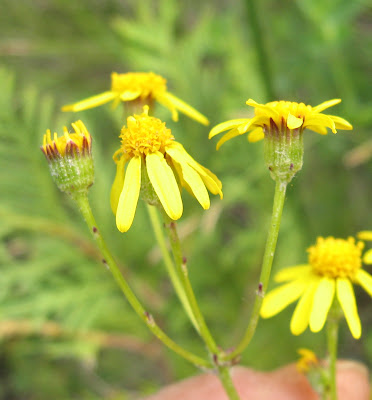"Look – to look at something for a reason, with an intention."
"See – anyone who is not blind can see, to see means to perceive anything in general. Seeing is not intentional, you see something because you can perceive it with your eyes."
Which brings us to one of my favorite odonate hunting spots on the north shore of Stoco Lake, where I look – with intention – not only for dragonflies and damselflies but species of any and all kinds that are new to me. Yet despite having surveyed this small area intensively for the past four years, I managed to overlook this small flower. It is by no means rare, there are dozens growing along the wet shoreline.
The shape and venation of the leaves ...
... and overall aspect of the flower spike suggest these little gems, only a few inches in height, might be orchids. In fact they are orchids – they're Wide-leaved Ladies' Tresses (Spiranthes lucida). The different kinds of Ladies' Tresses can be difficult to separate but the yellow insides of the flowers are a distinguishing characteristic of this species.
Last spring at the
Stoco Fen I came across what I assumed were Small Yellow Lady's Slippers (Cypripedium parviflorum). But having recently re-visited the fen I'm not so sure, and good science demands that in the light of new evidence it's necessary to re-examine this conclusion.
First, a few images of some Yellow Lady's Slippers found in the fen. The sepals and petals are definitly maroon and bit of red is just visible near the lip of the pouch in the second photo. Also looking at the habitat and their association with other Lady's Slippers that are already in full bloom, these are likely Cypripedium parviflorum.


Taking into consideration as a whole their size, habitat, the color of the petals and sepals, and the red spotting around the pouch, the orchids in the next photo are
Cypripedium parviflorum in their prime. But there's one thing I didn't take note of (I didn't know this at the time) – Small Yellow Lady's Slippers have a definite scent. Not all perception happens with the eyes ...

The Lady's Slippers in the next three images were encountered growing in shady woods. And much to my chagrin (unless this is their first year of bloom, which I doubt) I've been walking past these large, showy flowers for the past four years. Looking and not seeing ... again ...
The flowers are larger and the plants as a whole taller than the Lady's Slippers growing in the fen. The petals and sepals are distinctly green and there are no red markings in evidence around the pouch. Nor did these flowers have any scent – I'm learning slowly, but I am learning. So it's reasonable to conclude that we're looking at
Large Yellow Lady's Slipper (Cypripedium pubescens var. pubescens).
Found in association with the orchids above, the petals and sepals of this Large Yellow Lady's Slipper bear some broken reddish stripes and a few pale spots around the pouch, but it's nowhere near as boldly colored as the Small Yellow Lady's Slippers in the fen.
And the Lady's Slipper that I photographed at the fen last year? With the exception of habitat, it otherwise conforms to the description for the Large Yellow Lady's Slipper. So be it ...
Last year I took two pictures of another plant that I've found growing only in the vicinity of the fen, but photos of only the flowers and stem leaves proved to be insufficient to identify it.
The flowers are in bloom again, and this time I thought to capture images of the entire panicle, the phyllaries and the basal leaves. Plants in the wild can appear quite different than the perfect specimens found in field guides, but looking at all the variables as a whole – flowers, leaves, stem, habitat and range – it seems that my mystery plant is
Balsam Ragwort (Packera paupercula).



















